Energy Management
EPA Refrigerant Regulations: Elevate EPA 608 and Compliance Readiness
On December 27, 2023, the EPA released a chilling update in the Federal Register: the maximum monetary civil penalties for violating its regulations were increased. The new 2024 fines have shot up by about 3.2% from their 2023 levels.
The EPA will now impose hefty penalties on non-compliant retailers, up to $69,733 per day for initial violations and $57,617 per day per violation thereafter.

Businesses that run cold rooms or operate, service, repair, dispose of, or install equipment like refrigerators and HVAC systems containing hydrofluorocarbons (HFCs) or their substitutes are affected by this.
The American Innovation and Manufacturing (AIM) Act and Section 608 of the Clean Air Act gave the EPA the directive to tighten the reins on anti-environmental emissions.
Ozone-depleting substances with high global warming potential (GWP), found in refrigerants like chlorofluorocarbons (CFCs) and HFCs, pose a threat to the environment and human health.
There's a sense of urgency in the retail market as the legislation will be enforced starting January 2025. The threshold for monitored refrigeration assets has been lowered from units with over 50 pounds of refrigerant to 15 pounds. The AIM Act refrigerant threshold changes are meant to better manage HFCs by maximizing reclamation and minimizing leaks from equipment.
Trying to stay up-to-date with outdated maintenance software to manage multi-site refrigeration systems is a recipe for compliance nightmares.
We'll now discuss the AIM Act and how leveraging software-driven refrigerant leak detection and compliance solutions has become an operational imperative.
Read More: Refrigerant Compliance Management Software
Brief background of HFCs and the AIM Act
HFCs are potent greenhouse gases present in various cooling applications like air conditioners and refrigerators. Notably, refrigeration systems consume about half of the total energy required by a typical grocery store. Open refrigerated cases create heat, and managing humidity is tough. This affects how well the equipment works and how long fresh food lasts.
The impact of HFCs on global warming is hundreds to thousands of times greater than carbon dioxide (CO2) per unit of mass. To address this, the EPA introduced the AIM Act in December 2020.
This act mandates a significant reduction in HFC usage by phasing down certain HFCs by 85% of their historical baseline by 2036.
The EPA's proposed HFC Emissions Reduction and Reclamation Rule under the AIM Act extends these requirements to appliances using HFC refrigerants, including supermarket refrigeration systems.
This stricter regulation means more systems could be classified as "chronically leaky," potentially leading to hefty fines.
New EPA section 608 refrigerant regulations
Under the Management of Certain Hydrofluorocarbons and Substitutes under Subsection (h) of the AIM Act, two significant rules have been proposed to minimize HFC emissions:
- Technology transitions for refrigerant systems
- HFC refrigerant leak management
EPAs’ technology transition proposal for refrigerant systems
The first rule aims to reduce the GWP of refrigerants used in air conditioning and refrigeration equipment by adopting alternative systems. There’s a motion to discontinue R-410a systems by January 1, 2025, and completely ban their installation thereafter.
In response, businesses are required to explore alternatives like R32, R452B, and R454B due to their lower GWP.
Efforts led by ACCA and the HVAC community are underway to establish sell-through periods for this transition. By January 1, 2026, only refrigerants with less than 700 GWP will be permissible for stationary air conditioning and heat pump installations.
EPA’s HFC refrigerant leak management
Even if you overhaul your company’s HVAC and cooling systems to the recommended ones, you’d still have to deal with inefficiencies and potential leaks that could make you non-compliant.
Table: EPA guidelines for HVAC classification and compliance requirements
If your system holds 15 pounds or more of refrigerant with a GWP of 53 or higher, you've got a 30-day window to fix any leaks (or 120 days if an industrial shutdown is necessary).
The set leak thresholds vary at:
- 10% for comfort cooling appliances
- 20% for commercial refrigeration
- 30% for industrial process refrigeration (IPR)
Automatic leak detection systems (ALDs) are now mandatory for certain appliances with 1,500 pounds or more of HFC (or HFC substitutes with a GWP over 53).
While existing provisions under 40 CFR part 82, subpart F remain intact, excluding leak repair, the EPA is adopting a zero-tolerance stance on appliances exceeding federal government-set leak thresholds. But even for those that don't, precision in leak rate calculations and meticulous record-keeping (reports) are paramount.
Thus, using smart IoT-based FM tech that can detect leaks and automate compliance tasks would also ensure that you meet SLA contracts and generate accurate reports on leak rates and refrigeration performance at your facility.
Smart tech solutions for proactive refrigerant leak detection and tracking
According to the 2023 Thomson Reuters Risk & Compliance Survey Report, 65% of corporate risk and compliance professionals believe that leveraging technology to streamline manual processes would decrease the complexity and costs associated with risk and compliance.
Facilio's connected refrigeration solution delivers up to 20% energy savings for multi-site food retail stores and allows retail owners to optimize existing refrigeration systems to get ROI within 6 months.
Facilio operates on a modern cloud-based platform with IoT and AI to effectively monitor HVAC and refrigeration systems. It automates refrigerant inspections and real-time leak detection across stores, ensuring compliance with EU and US climate control regulations. By unifying data from various sources, it provides structured and clear information for custom reporting.
Features
IoT remote monitoring
Continuously remotely monitor refrigerant levels, pressures, and temperatures in real-time. You can also define rules criteria with complex relationships like sensor faults, performance, or energy consumption, and the software will set up monitoring stops to notify you at each point where there’s an anomaly.
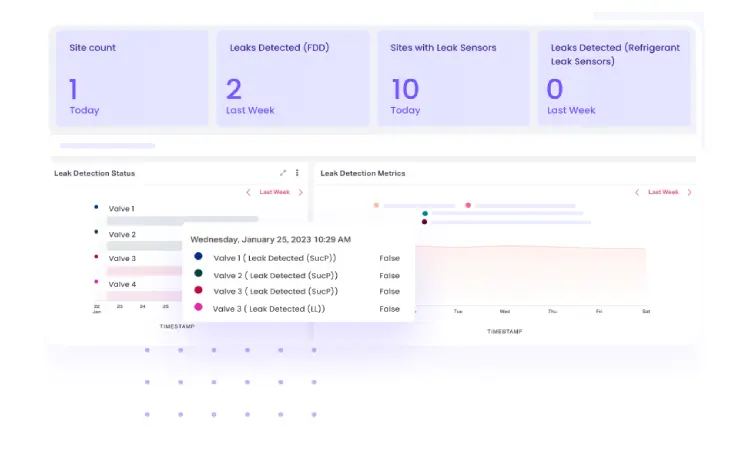

Portfolio-wide automation
Automated preventive maintenance inspections and rounds allow field teams to enter service records classified based on quantity at different sites across your portfolio. Additionally, the platform provides accurate insights into the overall state of refrigerant leaks over time. Learn more Best Preventive Maintenance Software
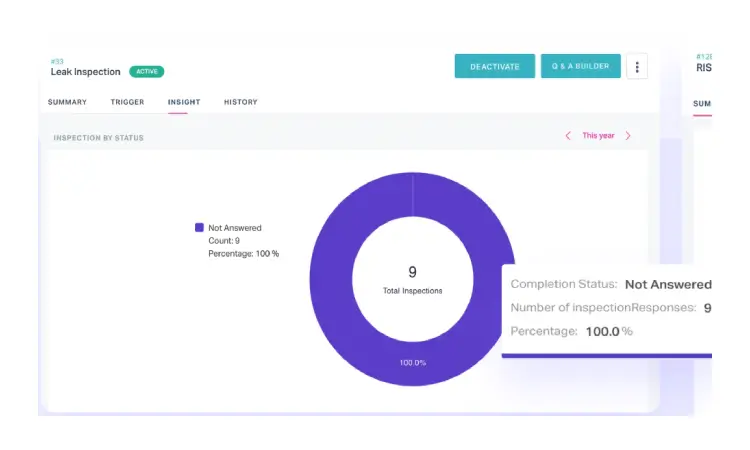
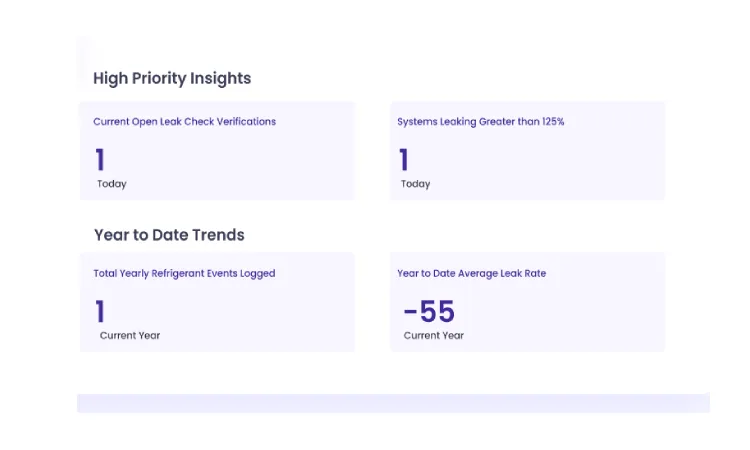
Derisk liabilities through organized data management
Auto-streamline refrigerant records and compliance data. You can digitize custom reports for routine audit reporting and regulatory stakeholders while integrating asset lifecycle and maintenance SLAs for comprehensive oversight.
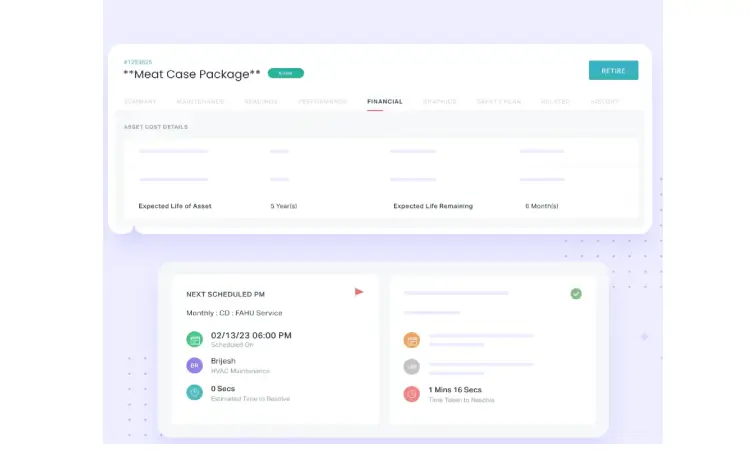
Generate digitized ESG reports
Facilio unifies HVACR data and reports from different sources into one neat package that's ready for audits. The software can generate accurate ESG reports, allowing you to see how far you’ve come with your compliance efforts.
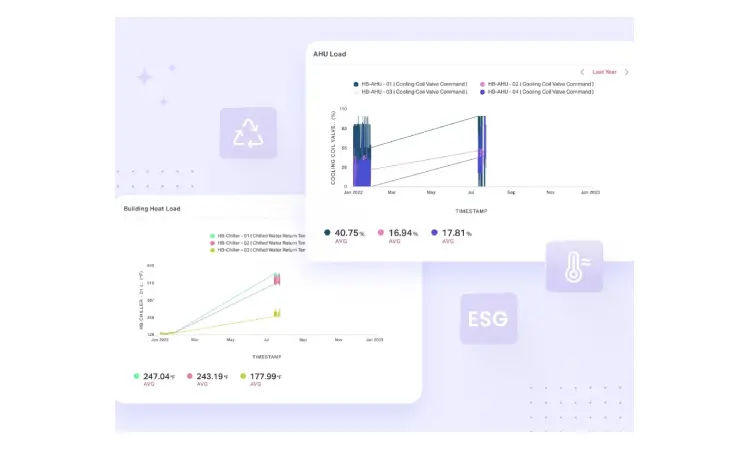
Connected data telemetry
Data from refrigerant-based assets is continuously and efficiently transmitted and processed to support informed decision-making and improve overall system performance.

Benefits of Facilio’s Connected Refrigeration Solution
- Centralize compliance operations
You can access standardized compliance report documentation for audits and inspections and implement consistent compliance protocols and procedures across multiple sites, all from one platform.
- Expiration date monitoring
Facilio tracks expiration dates for certifications and insurance, providing timely alerts to prevent lapses and maintain compliance.
- Workflow setup for compliance
Establish workflows within Facilio to prevent dispatching non-compliant providers, ensuring adherence to regulatory standards.
- Certification and insurance validation
Verify the validity of certifications and insurance for all providers working at your site locations.
- Record-keeping risk reduction
Reduce record-keeping risks by ensuring that all necessary paperwork from service providers is automatically collected and maintained.
Discover the tech that watches your back 24/7
To stay on top of the new regs, facility managers should prioritize the following:
- Leak repair and detection: Especially for appliances with over 1,500 pounds of refrigerant, and prioritize using ALD systems.
- Reclamation: Reduce HFC emissions by reclaiming and reusing refrigerants when possible.
- Recordkeeping and reporting: Implement innovative FM technology to track activities effectively, as stricter requirements are to be expected under the AIM Act.Discover how our solution supports facility managers in maintaining compliance and managing other facility-related issues by exploring Facilio refrigeration optimization software for compliance and risk management.



